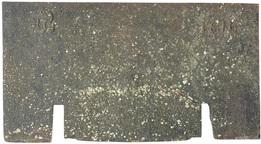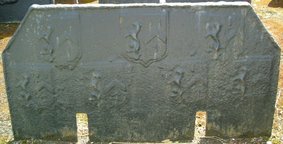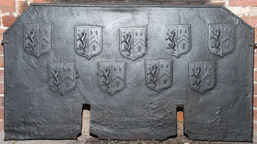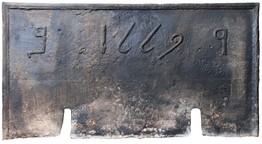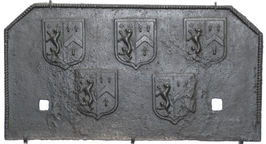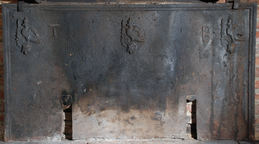-
1309
Description: Rectangular shape; no edging; top left, inverted 'renaissance' shield with the initials M above IE; top right, date 1671 in unseriffed numerals.
Notes: The shield with initials has not been noted on another fireback. The slots in the fireback are to accommodate andirons or firedogs.
Inscription: IME [triad] 1671
- Decoration tags:
- rectangular (shape)
- none (edging)
- carved stamps
- individual numbers
- text
Manufactured: in 1671 in England.
Current location: Lay's Auctioneers, Alverton Road, Penzance, Cornwall, England.
- Attached to series:
- Date & initials firebacks
- Andiron slot firebacks
-
599
Description: Canted rectangle; ovolo moulded edging (top and sides); seven shields of Ayloffe impaling Sulyard - two rows with three on top and four on the bottom; two parallel vertical cuts for the insertion of firedogs.
Notes: Ayloffe: sable, a lion rampant Or, collared gules, between three crosses formy of the second; Sulyard: argent, a chevron gules between three pheons inverted sable. William Ayloffe (c1535-1584) of Bretons, Hornchurch, Essex, Justice of the Court of Queen’s Bench, married (c1560) Jane, dau. of Sir Eustace Sulyard, of Runwell, Essex. There is a large number of variants using the same shields.
Arms: Ayloffe impaling Sulyard (William Ayloffe of Bretons, Hornchurch)
- Decoration tags:
- rectangular with canted top corners (shape)
- rope (edging)
- carved stamps
- armorial
Manufactured: in the early-17th century in the Weald area of England.
Current location: Mark Ripley Forge & Fireplaces, Northbridge Street, Robertsbridge, East Sussex, England.
- Attached to series:
- Ayloffe series
- Personal armorial firebacks
- Andiron slot firebacks
-
663
Description: Rectangular, with canted top corners; twisted rope edging (top and sides only); nine shields of Ayloffe impaling Sulyard in two rows, 5-4; two parallel vertical cuts for the insertion of firedogs.
Notes: Ayloffe: sable, a lion rampant Or, collared gules, between three crosses formy of the second; Sulyard: argent, a chevron gules between three pheons inverted sable. William Ayloffe (c1535-1584) of Bretons, Hornchurch, Essex, Justice of the Court of Queen’s Bench, married (c1560) Jane, dau. of Sir Eustace Sulyard, of Runwell, Essex. There is a large number of variants using the same shields.
Arms: Ayloffe impaling Sulyard (William Ayloffe of Bretons, Hornchurch)
- Decoration tags:
- rectangular with canted top corners (shape)
- rope (edging)
- carved stamps
- armorial
Manufactured: in the early-17th century in the Weald area of England.
Current location: in private hands, Rolvenden, Kent, England.
- Attached to series:
- Ayloffe series
- Personal armorial firebacks
- Andiron slot firebacks
-
903
Description: Rectangular; ovolo-moulded edging (top and sides); date between split initials across upper half of plate; two notches cut away for insertion of firedogs.
Notes: The ‘6s’ appear to have been moulded from a type of jemmy.
Inscription: g 1669 P [reversed]
- Decoration tags:
- rectangular (shape)
- ovolo (edging)
- simple stamps
- carved stamps
- individual letters
- individual numbers
- text
- objects
Manufactured: in 1669 possibly in the Weald area of England.
Current location: George & Dragon Inn, Speldhurst Hill, Speldhurst, Kent, England.
-
741
Description: Rectangular, with canted top corners; twisted rope edging (top and sides only); five shields of Ayloffe impaling Sulyard in two rows, 3-2; Ayloffe: sable, a lion rampant Or, collared gules, between three crosses formy of the second; Sulyard: argent, a chevron gules between three pheons inverted sable. Two cut notches probably for firedogs.
Notes: William Ayloffe (c1535-1584) of Bretons, Hornchurch, Essex, Justice of the Court of Queen’s Bench, married (c1560) Jane, dau. of Sir Eustace Sulyard, of Runwell, Essex. A large number of variants use the same shields. The excrescences affecting the left and right sides respectively of the lower shields are the result of inexpert ladling of the iron during casting. Part of the bequest to the Victoria and Albert Museum by Lieut. Colonel G. B. Croft-Lyons in 1926.
Arms: Ayloffe impaling Sulyard (William Ayloffe of Bretons, Hornchurch)
- Decoration tags:
- rectangular with canted top corners (shape)
- rope (edging)
- carved stamps
- armorial
Manufactured: in the early-17th century in the Weald area of England.
Current location: Victoria & Albert Museum, Cromwell Road, Kensington & Chelsea, Greater London, England.
Museum number: M.621-1926 (part of the Victoria & Albert Museum museum group)
- Attached to series:
- Ayloffe series
- Personal armorial firebacks
- Andiron slot firebacks
-
943
Description: Rectangular shape; ogee moulded edging (top and sides); crowned falcon stamp repeated three times and spaced evenly along the top; separated initials close inside outer falcon stamps; two andiron slots.
Notes: The stamp, which was originally a badge of Queen Anne Boleyn, and first used in the letters patent of her Marquisate of Pembroke, comprises a falcon with a crown upon its head and holding a sceptre, standing upon a tree stump, from which extends a sprig of red and white roses. The badge was later adopted by Queen Elizabeth I. The probability must exist that the initials TB relate to a member of the Boleyn family.
Inscription: T B
- Decoration tags:
- rectangular (shape)
- cyma reversa/ogee (edging)
- carved stamps
- individual letters
- heraldic
- historical
- text
- animals
- plants
- objects
Manufactured: in the 16th or 17th century in the Weald area of England.
Current location: in private hands, Woodchurch, Kent, England.
- Attached to series:
- Miscellaneous stamp firebacks
- Andiron slot firebacks
